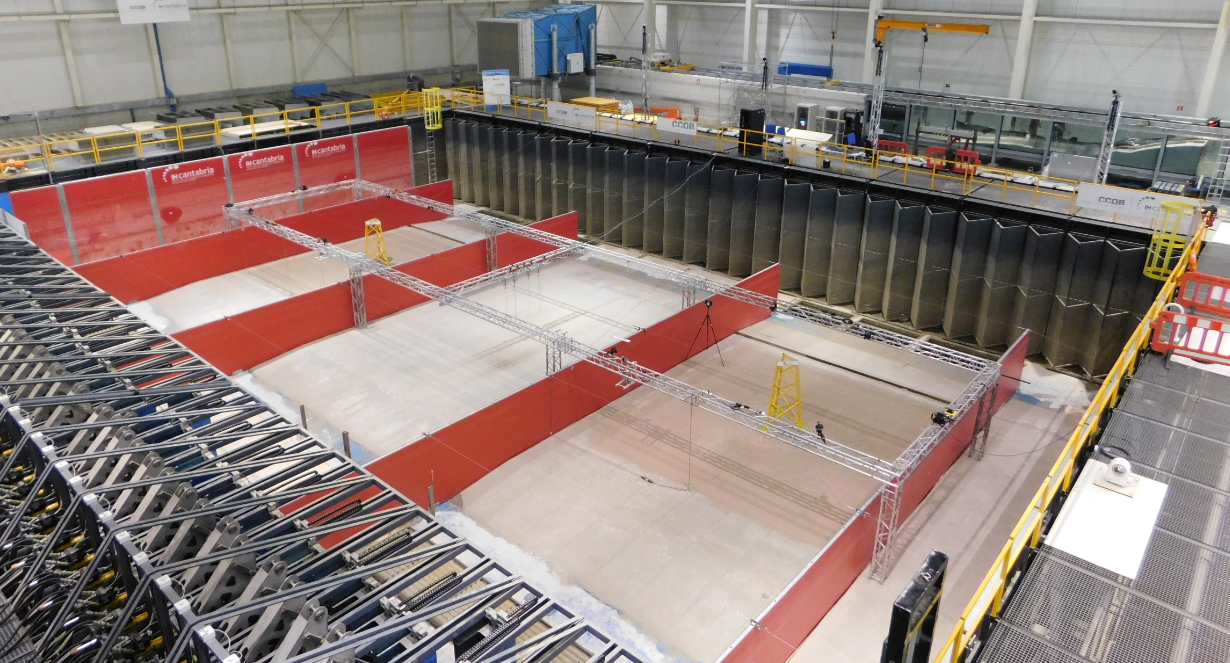With methodologies that evaluate scour around complex structures, IHCantabria transcends internationally

The results of projects related to scour assessment and mitigation have been presented in national and international events, such as WindEurope 2024. A flagship project is SOCAVA, which is part of IHCantabria’s Marine Science Program.
The valuable experience of the Environmental Hydraulics Institute of the University of Cantabria(IHCantabria)) in fluid-structure-soil interaction research continues to grow, thanks to a novel hybrid strategy that combines the application of semi-empirical formulations, advanced numerical modeling and large-scale experimental tests, making IHCantabria a key player in the analysis of scour and the design of scour protections for structures supported or piloted on the seabed.
Senior researcher Javier Sarmiento spoke on this topic at WindEurope 2024, an annual event held in Bilbao from March 20-22, which brought together more than 12,000 professionals from the wind energy sector. Wind Europe is the leading wind energy association in Europe with more than 500 members. Its main objective is to promote this type of energy and to create a working group in which the entire sector is represented. Its representatives meet every year at the WindEurope Annual Event, such as the one held recently in Bilbao.
Within the framework of this event, Javier Sarmiento presented a poster and an oral communication entitled “Methodology to evaluate scour development around complex structures”. These materials were exhibited on behalf of a group of researchers from IHCantabria, which was formed by him, Sergio Fernández, Raúl Guanche and Íñigo Losada. In his presentation, Sarmiento highlighted the contribution of this institute to the development of innovative approaches to understanding and mitigating scour around offshore foundations.
Relationship with the SOCAVA project
The line of research that Javier Sarmiento referred to at the annual WindEurope 2024 event is the one applied in the SOCAVA project, which is part of the Institute’s Marine Sciences Program (PCM) and is framed within the Complementary Plan for R&D&I in Marine Sciences, ThinkInAzul. Its execution is financed by the Ministry of Science, Innovation and Universities(MICIU), with funds from the Spanish Recovery, Transformation and Resilience Plan(PRTR), through the European NextGenerationEU funds, and by the Government of Cantabria.
The SOCAVA project promotes the validation of a pioneering and comprehensive methodology to analyze scour around offshore structures fixed to the seabed. With the integration of semi-empirical solutions, state-of-the-art numerical models and experimental techniques, this project deepens the evaluation of scour processes around critical structures, such as electrical substations. Its comprehensive approach allows determining the need and optimization of anti-socavation protections.
According to Raúl Guanche García, head of the Offshore Engineering and Marine Energy Group at IHCantabria, the SOCAVA project aims to “position IHCantabria as a benchmark in the analysis and prevention of scour around complex structures on the seabed”. He, Javier Sarmiento Martínez and Álvaro Álvarez Vázquez (responsible of the Hydraulics, Coastal and Offshore Laboratory at IHCantabria) are participating in the development of this project.
One of the expected results of the SOCAVA project is the development of a proprietary database to establish robust semi-empirical approaches for understanding and preventing scour in various marine structures. This project is closely aligned with Sustainable Development Goal 7, because it seeks not only to improve the scientific-technical competitiveness of IHCantabria, but also to contribute to ensuring universal access to affordable, safe and sustainable energy.





